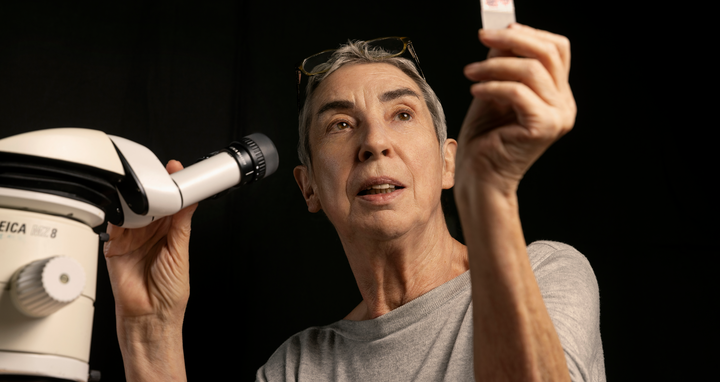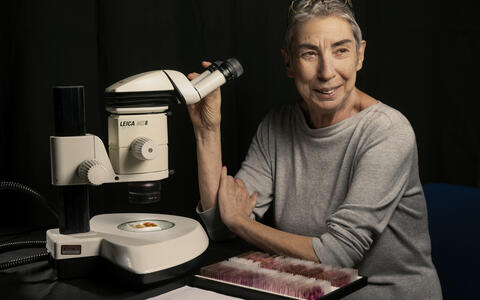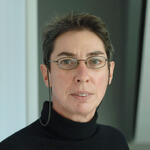The cartographer of life
Skeletal muscle is a hugely important organ for movement and metabolism. Muscle also accounts for almost 40 percent of our body weight.
Professor Carmen Birchmeier is fascinated by muscles – how dynamic they are, how they expand and contract, and how they are able to renew themselves. “Skeletal muscle is a hugely important organ for movement and metabolism,” she says. “Muscle also accounts for almost 40 percent of our body weight.” The scientist then dives straight back into explaining the molecular details and finely tuned mechanisms that underlie muscle’s many incredible abilities – such as its ability to repair or regenerate following injury.
Birchmeier is a developmental biologist and genetic researcher who heads the Developmental Biology and Signal Transduction Lab at the Max Delbrück Center. Armed with an insatiable curiosity, she is always keen to delve into new questions surrounding the fundamental workings of the body. She also manages to retain the playful lightness required to fathom the complexity and contradictory nature of molecular processes without getting too bogged down – and even to accept that there are some we do not yet understand. “These are among the great mysteries of nature,” she says with both humility and determination.
Carmen Birchmeier could be described as a cartographer of life; she maps the signaling pathways that evolution has laid down in our genetic makeup to produce and maintain vital biological functions. “These mechanisms have a logical structure,” explains Birchmeier. “You can break them down and strengthen or weaken their function in order to treat disease.” One example she gives is the so-called Notch signaling pathway, which she and her team have shown to be essential for muscle growth and regeneration.
Muscle healing at the molecular level
A healthy muscle fiber consists of thousands of serially arranged units called sarcomeres. They are composed of protein filaments that slide over each other to contract or relax muscle. This is a masterfully orchestrated process that generally runs smoothly, but too much mechanical force can produce small tears in the sarcomeres. “When this happens, the cells’ nuclei migrate to the affected areas and activate certain genes that are involved in the repair process,” explains Birchmeier.
If this spontaneous repair response does not work, the muscle fiber dies. Macrophages then clean the site of the injury before muscle stem cells come onto the scene. “They start dividing like crazy, which is the start of a second stem cell-based repair process that we call regeneration,” explains Birchmeier. In mouse models, it takes seven days for destroyed muscle tissue to fully regenerate. But how are these healing processes controlled at the molecular level? And what happens when the underlying signaling pathways are disrupted?
An unexpected career path
Carmen Birchmeier’s life of questioning and exploration began with her obtaining a degree in chemistry in the ’70s from the University of Konstanz. However, she quickly found chemical laboratory work too monotonous. After moving to San Diego with her husband, Walter Birchmeier, she discovered the burgeoning field of molecular biology, which she remembers being “new and fascinating.” She returned to Europe not long thereafter and began research for her doctoral thesis at the University of Zurich, where she looked into how mRNA – an important player in protein production – is created from DNA. She was able to show that the process of mRNA synthesis ends with a precise cut made by a nuclease enzyme. She also learned how to manipulate genes: “During that time, my doctoral supervisor Max Birnstiel became the first person to clone protein-coding genes.” Suddenly, Birchmeier found herself at the forefront of this field and with access to the most advanced techniques.
She returned to the United States, this time to Cold Spring Harbor in New York State, and dove headlong into an entirely new research area: oncogenes – the parts of the genome that can cause cancer. Her focus was on tyrosine kinase oncogenes, which were known to code for proteins in signaling pathways. However, no one knew what these cancer-causing genes were responsible for otherwise. Birchmeier was able to show that they are developmental genes that regulate the growth of progenitor cells and help ensure that they reach their destinations when the organs develop. This was a surprising connection. “And that’s how I became a developmental biologist,” says Birchmeier, laughing at the unexpected turn of events.
“That’s how I ended up in neuronal development”
After qualifying as a professor in Cologne in 1995, Birchmeier moved to the Max Delbrück Center, where she continued her work on tyrosine kinases. One of these enzymes – called MET – plays a key role in transmitting signals during embryonic muscle development. It causes muscle progenitor cells to migrate into the arm and leg buds. For these discoveries she was awarded in 2002 the Gottfried Wilhelm Leibniz Prize by the German Research Foundation (DFG). This marked the start of her enduring fascination with muscles.
It was the unanswered questions and inconsistencies that drove Birchmeier to venture into unexplored terrain. Her research at the Max Delbrück Center has looked at what role other signaling pathways play in organ development, discovering, for example, that the genes that cause muscle progenitor cells to migrate also help regulate the formation of the nervous system. “That’s how I ended up in neuronal development,” Birchmeier says in her own pleasantly offhand way, as if it had happened by pure chance. Though successful in uncovering fundamental mechanisms in nervous system development, she has focused above all on open questions about musculature.
For instance, it was unclear whether the many nuclei in muscle cells – there are more than 200 in mice – are all the same. “We labeled and analyzed them using single-nucleus sequencing,” says Birchmeier. In 2020 her studies made clear that the many nuclei within a single muscle cell transcribe entirely different genes and have specialized functions, such as repairing muscles. She and her team were able to identify around 75 genes that start the degradation of damaged proteins in the sarcomeres of muscle cells and trigger the production of new ones. She has dubbed this repair squad the “fiber repair cluster.”
How dormant muscle stem cells awaken
Another open question was how the muscle stem cells would know that spontaneous repair had failed and that they should intervene. The Notch signaling pathway plays a crucial role here. Normally, two genes balance each other within this pathway – they first increase and then decrease expression in a rhythmic pattern. By labeling them with light-producing enzymes, Birchmeier can make the oscillation visible under the microscope. She recognized that this balancing mechanism facilitates muscle regeneration. Her team has also discovered that a protein, the HES-1 transcription factor, ensures that muscle stem cells remain in a kind of dormant state and return to dormancy after the regeneration process is completed.
As always, she decided to dig deeper and found out that HES-1 represses another transcription factor, MyoD. Cells can divide as long as the HES-1/MyoD balance is undisturbed. However, if MyoD gets the upper hand, the cells begin to fuse with one another to form a new muscle fiber. Yet it is unclear what causes the balance to tip in favor of one transcription factor or the other – and thus inducing either differentiation or a dormant state. Which signaling pathways are involved in this process is one of nature’s great mysteries – at least for the time being.
She will tackle this mystery, too, with her playful lightness, and maybe even solve it. In the meantime, she is also enjoying the finer things in life, such as the garden behind her house near Berlin-Buch that her husband tends to, the evening meal she makes from his harvest, and a glass of good red wine to go with it. “Sometimes I poke fun at myself and say that I only take two things seriously – science and cooking,” she confides.
Exploring future therapies
Sometimes I poke fun at myself and say that I only take two things seriously – science and cooking.
The finely tuned molecular processes that Birchmeier is uncovering could change the future of medicine. That’s because the balance between genes is pathologically disrupted in rare muscle diseases like Duchenne muscular dystrophy (DMD). “Regeneration works quite well for a few years, but over time the muscle stem cells become exhausted,” says Birchmeier. The muscles of DMD patients waste away, and most sufferers die of respiratory failure or cardiac arrest. Birchmeier’s team has already created a mouse model that genetically mimics the disease. Single-cell sequencing revealed that the specialized nuclei in the muscle fibers of diseased mice become disorganized – and that new kinds of nuclei appear, including some that characterize the 75 genes that compose the fiber repair cluster. However, the sequencing also showed that this spontaneous repair mechanism was no longer working up to par.
“We hope that at some point we will understand the repair mechanism well enough to be able to specifically activate or strengthen it,” says Birchmeier. “After all, we know that signals are exchanged for precisely this purpose and that they can be altered so that they do such things as turn on more repair genes.” Together with clinical researcher Simone Spuler, Birchmeier wants to improve the fate of DMD patients. She also wants to examine more closely the 75 genes in the fiber repair cluster. “I would like to find out if these are all actually repair genes, and, if so, if it is possible to manipulate them for therapeutic purposes.” She will dig deeper, unlocking the secrets of even more signaling pathways – because such meticulously mapped-out knowledge will help shape the future.
Text: Mirco Lomoth








